
- Home
- News
- Analysis
- States
- Perspective
- Videos
- Education
- Entertainment
- Elections
- World Cup 2023
- Features
- Health
- Budget 2024-25
- Business
- Series
- NEET TANGLE
- Economy Series
- Earth Day
- Kashmir’s Frozen Turbulence
- India@75
- The legend of Ramjanmabhoomi
- Liberalisation@30
- How to tame a dragon
- Celebrating biodiversity
- Farm Matters
- 50 days of solitude
- Bringing Migrants Home
- Budget 2020
- Jharkhand Votes
- The Federal Investigates
- The Federal Impact
- Vanishing Sand
- Gandhi @ 150
- Andhra Today
- Field report
- Operation Gulmarg
- Pandemic @1 Mn in India
- The Federal Year-End
- The Zero Year
- Premium
- Science
- Brand studio
- Home
- NewsNews
- Analysis
- StatesStates
- PerspectivePerspective
- VideosVideos
- Entertainment
- ElectionsElections
- Sports
- Loading...
Sports - Features
- Budget 2024-25
- BusinessBusiness
- Premium
- Loading...
Premium

Why everybody's favourite Manali is teetering on the brink
Apart from the snow-capped Himalayas, Manali is a unique combination of Indian art, history, culture, spirituality, and an astonishing natural environment. Due to the influx of tourists, Manali is losing it all.

Eighty-five-year-old Gayaso Devi, who has lived in Manali all her life, recalls a legend from the Hindu mythology about the mountain town. “When Earth’s destruction was happening 5000 years ago and the entire earth was contained in water during the great floods, Lord Vishnu incarnated as a Matsya (fish). Matsya saved the world from a great flood. Manu, referred to as the first man of...
Eighty-five-year-old Gayaso Devi, who has lived in Manali all her life, recalls a legend from the Hindu mythology about the mountain town.
“When Earth’s destruction was happening 5000 years ago and the entire earth was contained in water during the great floods, Lord Vishnu incarnated as a Matsya (fish). Matsya saved the world from a great flood. Manu, referred to as the first man of the universe, caught a little fish that grew to a giant size. When the flood approached, Manu saved himself by tying his boat to the horn on the fish’s head.”
“The fish protected his boat and took the boat to peaks of the Himalayas in Manali. This place was named Manali because Manu lived here,” she says.
Locals revere the historical Manu temple in Old Manali in the belief that Manu meditated here and recreated human life here.
The octogenarian is however sad now as the new generation does not know anything about these things.
“New buildings have come up in the city and Manali, which should be famous for Manu temple, is now famous for those buildings on the riverside. The tourists don’t visit Manu temple nor do they want to know about Manali. They just come to New Manali, eat, drink, take photos and go back.”
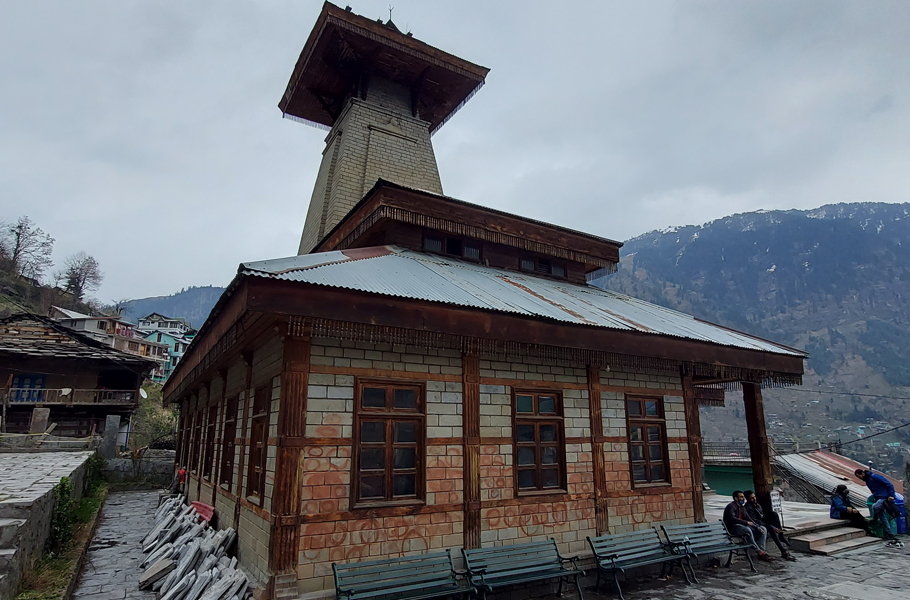
A must-see for all tourists
Located in Kullu district of Himachal Pradesh, Manali is situated at an altitude of 2050 meters above sea level and is spread along the banks of the Beas River. Manali is well-known for its lush green pine forests, snow-clad mountain peaks, valleys, serene rivers and lakes. Apart from sightseeing, tourists come for adventure sports including for skiing, hiking, mountaineering, paragliding, rafting, trekking, kayaking and mountain biking.
“Himachal Pradesh is a much sought-after tourist destination, The tourists prefer Dharamsala as it is the abode of Tibetan leader Dalai Lama, Shimla the ‘Queen of hills’ and reminiscent of British architecture, Kullu-Manali for snow and adventure and Rohtang Pass for being the gateway to Lahaul and Spiti,” says Rajesh Kumar, a tourist guide in Manali.
Although an extended summer is the peak season, tourists also flock these places during winter to enjoy the snowfall.
Manali alone caters to nearly 40 lakh tourists—including 5 lakh foreign and 35 lakh domestic—every year, as per the state tourism department.
There was a 7.38 and 4.57 per cent increase in foreign and domestic tourists respectively in 2019 as compared to 2018.
Apart from the snow-capped Himalayas, Manali is a unique combination of Indian art, history, culture, spirituality, and an astonishing natural environment. Due to the influx of tourists, Manali is losing it all.
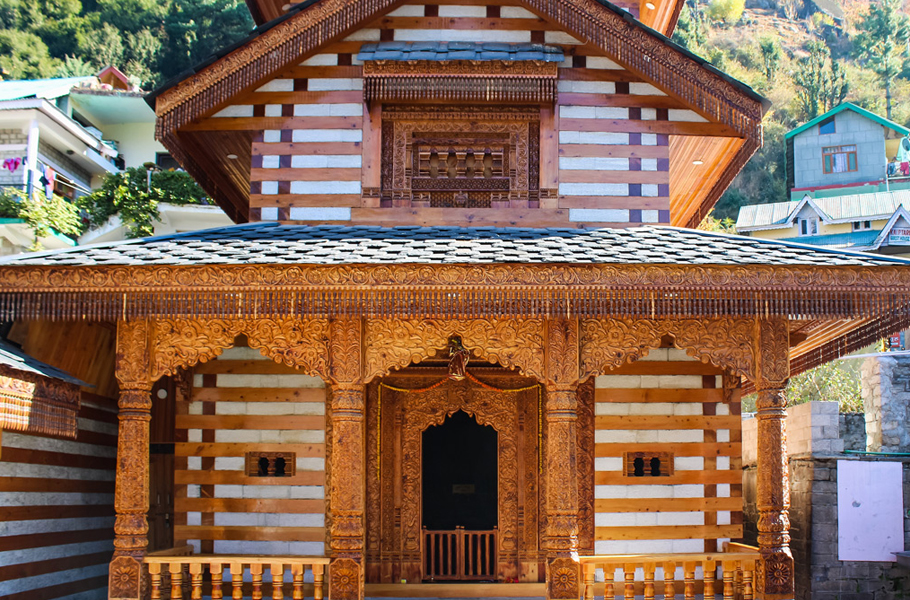
Losing historical sheen
Manali is a historical town that finds mention in various incidents of Indian history. The town is actually a collection of three adjacent hills. Each hill has a village and an old temple: Manu Temple in Old Manali, Vashishtha Temple in Vashishtha and Hadimba Temple in Dhungri.
While Vashishtha temple finds its mention in Ramayana, Hadimba Temple has relevance in Mahabharata, the two main epics of Hindu mythology.
Vashisht temple is dedicated to sage Vashishtha, the teacher of Lord Ram and Laxman. The Vashisht temple is believed to be more than 4000 years old. Founded by Vashishtha, the village was once the home of the Vashisht clan.
According to a local, “Rishi (sage) Vashishtha was depressed to find out that his children had been killed by Vishwamitra. Rishi Vashishtha tried to commit suicide by jumping into a river but the river refused to kill him. He then started a new life in the village here. The river which took the rishi to the village was named Vipasha, meaning freedom from bondage. The Vipasha River is now known as the Beas River.”
The ancient Hadimba temple on the other hand stands within a dense cedar forest, so much that little sunlight makes its way through. The temple was built by Maharaja Bahadur Singh in 1553.
Devotees believe that the temple stands at the site where Hindu deity Hadimba (Hidimba) meditated. Hadimba, who was born in a rakshasa (demon) family, married Bhim, one of the five Pandava brothers in Mahabharata. The forest around the temple was terrorised by her brother, Hidimb, who was killed by Bhim in a fierce battle.
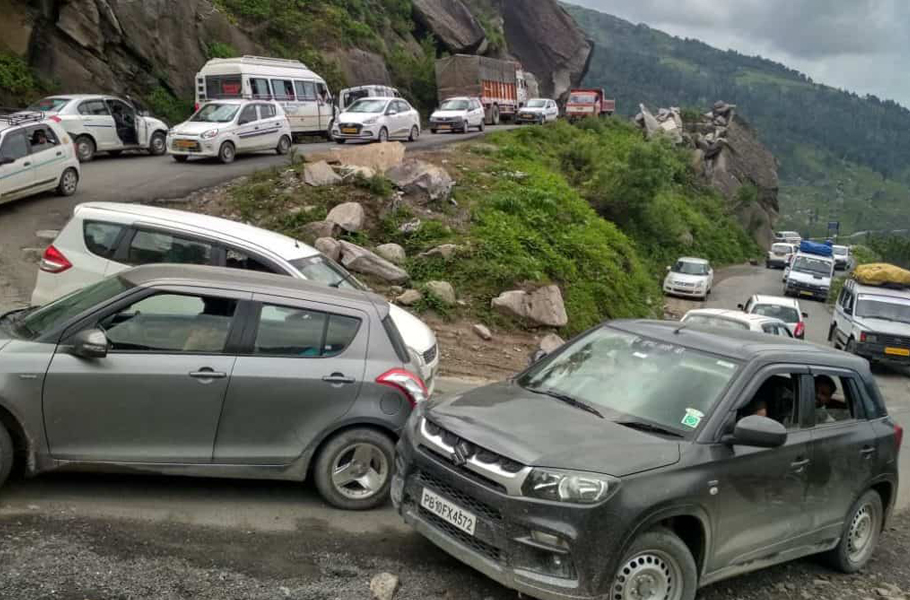
Sopan Sharma, a local resident of Manali says, ”We have the temples which are the gateway to the history of not only Manali or India but to the world. But after the influx of tourists started, a new Manali was established and the old Manali was forgotten. There are no roads or development in Old Manali as every development took place for tourists in New Manali. To our surprise, foreigners are more interested in listening to the history of all the temples but Indians discredit it.”
He says a good number of tourists come looking for weed or are already intoxicated. “They think near temples, you will get ‘maal’ (marijuana). They are killing our culture.”
Unlike earlier, when Vashishtha village and the temple were the centre of the city, it has been cut off from the city now and Mall Road is the new heart of the city, with alcohol cafes and big shops, he rues.
To meet the everyday demand of tourists, the lush green pine trees around Hadimba temple have been cut at a large number, he adds.
Kathkuni, a fast vanishing art
It is not just the historical temples and forests that face neglect and extinction. ‘Kathkuni’ woodwork, a style of building houses found largely in Himachal Pradesh, is fast losing out to concrete brick and mortar.
Kathkuni originates from two Sanskrit words— ‘kastha’ meaning wood and ‘kone’ meaning corner. This indigenous style consists of walls made of interlocked wooden planks with stones packed in between without mortar.
It is said that this type of architecture helped the buildings survive many earthquakes. Another characteristic of the temples and other buildings are the various styles of roofs—tower-shaped, pyramid-like, gables, etc. Many of the upper stories have balconies with ornamental railings.
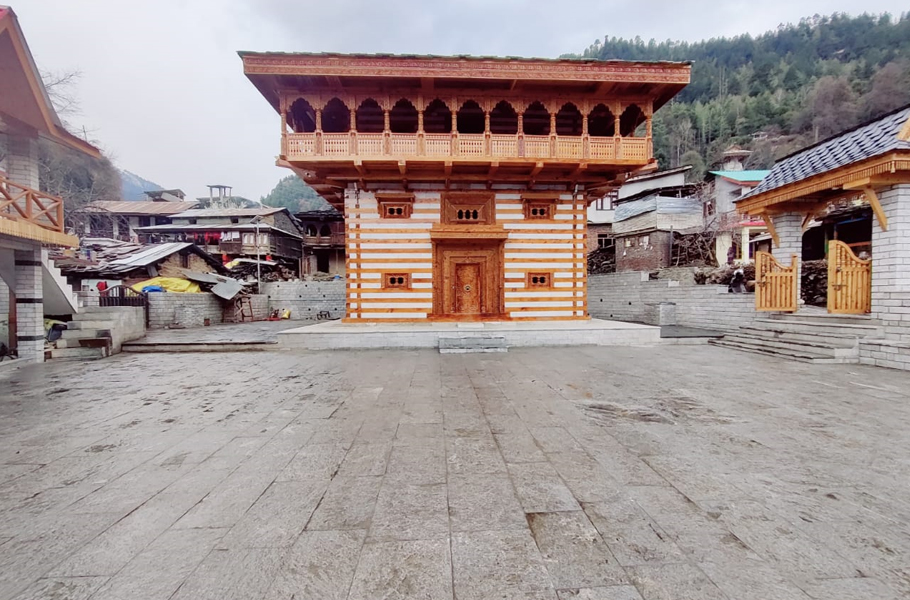
From homesteads to temples, once upon a time, it was very popular in the region. Years of neglect and ill-advised renovation as well as the advent of modern building materials have almost dealt a death blow to this vernacular art.
“Apart from landmark buildings such as the Hadimba Devi temple in Manali or the former castle of Naggar, the art is almost extinct in Manali. This art needs expertise, money and time to build. But as Manali has commercialised now, old buildings have turned into hotels or guest rooms. People have sold their land, so this art is vanishing,” says tourist guide Rajesh.
Environmental degradation
For a town that has only about 8,600 residents, but more than 1000 hotels and 500 home-stay units—and the population swells to lakhs during the peak summer and winter seasons—it is today a picture of neglect with traffic congestion, haphazard growth and inadequate civic amenities.
It was the environmental vulnerability assessment of Manali by the National Environmental Engineering Research Institute (NEERI), Nagpur, in 2013, that first highlighted the deterioration.
The report points out that the air quality has been impacted badly amid a looming threat of waterborne diseases.
The study indicated that the road width was not enough to sustain heavy traffic, a cause for higher emissions. The lack of parking space results in constant traffic jams. The lone garbage disposal facility is woefully inadequate, the result of which is piles of garbage on the roads and on the peaks.
Jagdish Kuniyal, professor, GB Pant Institute of Himalayan Environment and Development, says, “Manali has lost a lot due to increasing pressure of tourism. It takes up the problems of over-construction of hotels, deforestation, air pollution, solid waste, water pollution and also suggests some mitigating measures to lessen the load of different forms of pollution.”
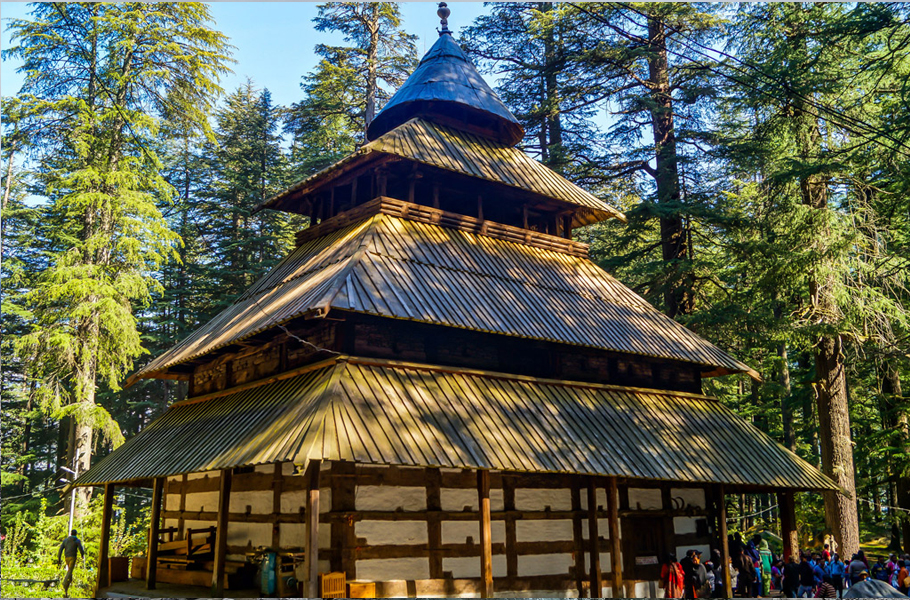
“Hotel construction registered its highest growth in this region (about 38%) during the 80s and this trend is the same even now. One-quarter of the hoteliers and tourists consider deforestation as one of the topmost problems arising due to unregulated tourism. Air pollution studies show that suspended particulate matter (SPM) has gone up to 160 µg/m³ at Manali during summers.”
“An in-depth study of the total waste generated shows that the proportion of decomposing waste (nearly 63% in Kullu and 72% in Manali) is higher than that of non-biodegradables. Indiscriminate throwing of municipal solid waste into rivers is common practice in these tourist spots, as a result, river water is continuously being polluted,” he adds.
Climate change woes
“If you had come to Manali three-four years ago, you could have seen the snow at this time of the year (February). At that time, the snowfall went on till March. But now, it ends in January because Manali has become hotter,” says Devendra Singh, a taxi driver in Manali.
Manali has seen an increase in both minimum (0.35 degree Celsius) and maximum temperature (1.1 degrees Celsius) and a decrease of nearly 9.01 cm in annual average rainfall in the 21st century as compared to mid-20th century.
Farmers in Himachal Pradesh, particularly in Kullu and Manali, are the worst affected. Failure of a large number of crops and decline in apple production due to rising temperature and reduction in cold hours during the last two decades have affected more than 80% of people’s livelihood dependent on agricultural pursuits.
Rajiv Kimta, an orchardist in Manali, says, “Compared to the previous year, this year, scanty snowfall was witnessed in Manali. This is an every-year trend. Generally every year, more than 30 cm of snowfall was witnessed in the area at least in two intervals during the winter season, which maintains moisture in the land. But from the last two years, only 20 cm of snowfall was observed in one interval and the climate is quite adverse for apple orchards. We are facing losses now. ”
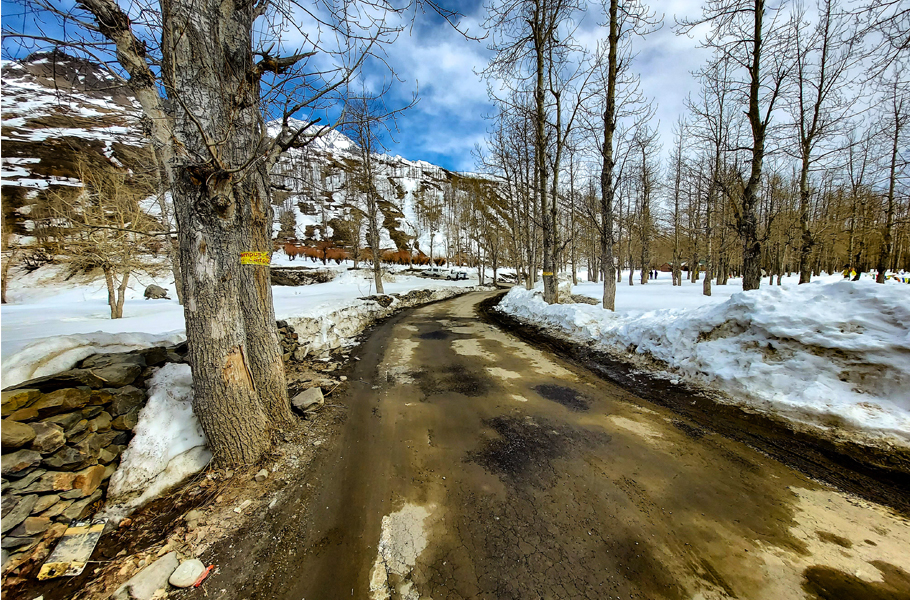
Not only on the Himalayas but people on the plains also suffer due to lack of snowfall as the water from the snow goes through rivers. Himachal Pradesh is home to five river basins contributing to Indus & Ganges river basins. These five river basins are Beas, Satluj, Yamuna, Ravi & Chenab.
DC Rana, director and special secretary, Himachal Pradesh Environment and Science Department (HPESD) says, “The severity of climate change impacts is observable and devastating at the local level, especially among the poor and ethnic people settled in the marginal and ecologically fragile areas, because of their least adaptive capacities and resilience.”
“Himachal Pradesh is in particular very sensitive to climate change and its environmental health is important to maintain water cycles and various ecosystem services for more than 200 million people down the line. But due to the impacts of climate change on this mountain landscape, these services are under tremendous threat,” he added.
“We will guide the field level functionary in Beas River basin in Kullu Manali through a simplified understanding of climate risks, vulnerability to climate change and actions to cope with the impact of climate change by connecting adaptation, mitigation and sustainable development, regional climate change strategies, climate change adaptation and disaster risk reduction, climate financing, sustainability,” says Manisha Nanda, Additional Chief Secretary, HPESD.
“It includes an analysis of observed and projected climate change over Kullu region at Panchayat level and the socioeconomic impacts of extreme weather events in the Beas Basin. I am sure that this will facilitate the planning process in forestry, terrestrial ecosystems and biodiversity, water resources sectors, settlements, human health, energy,” she added.

